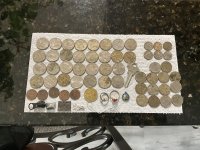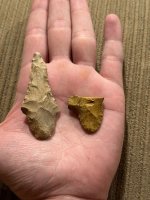skyhawk1251
Sr. Member
I've read several versions of the "Wagoner's Lost Ledge" tale, but the source that I'm using here is taken from Barry Storm's book, "Thunder Gods Gold." Other versions are essentially the same.
This is my favorite tale of lost gold in the Superstition Mountains. It seems to be well documented, and a map comes along with it. There are many rocky outcroppings just west of Picacho Butte and south of LaBarge Canyon, so it would take a lot of prospecting to examine all the possible locations of a lost ledge. I would guess, though, if the tale can be considered to mostly be accurate facts, that a tired, hungry man, who was looking for the shortest, easiest way to get where he wanted to go, would give preference to low ground in the arroyos. Also, according to the tale, Wagoner planted trees around the ledge. Trees need a reliable water source to grow, so this suggests a location near an arroyo.
With those clues in mind and using GE, I see one, possible location for the lost ledge. It's not the only possibility; there are surely others, and possibly many others, due to the abundance of outcroppings. The place I've found, however, would make me stop in my tracks and give it close scrutiny.
I'm not providing GPS coordinates for the place shown in the GE image below. Follow the right-forking arroyo in the wide-angle view and that place will be found. LaBarge Canyon winds to the left in the image.








This is my favorite tale of lost gold in the Superstition Mountains. It seems to be well documented, and a map comes along with it. There are many rocky outcroppings just west of Picacho Butte and south of LaBarge Canyon, so it would take a lot of prospecting to examine all the possible locations of a lost ledge. I would guess, though, if the tale can be considered to mostly be accurate facts, that a tired, hungry man, who was looking for the shortest, easiest way to get where he wanted to go, would give preference to low ground in the arroyos. Also, according to the tale, Wagoner planted trees around the ledge. Trees need a reliable water source to grow, so this suggests a location near an arroyo.
With those clues in mind and using GE, I see one, possible location for the lost ledge. It's not the only possibility; there are surely others, and possibly many others, due to the abundance of outcroppings. The place I've found, however, would make me stop in my tracks and give it close scrutiny.
I'm not providing GPS coordinates for the place shown in the GE image below. Follow the right-forking arroyo in the wide-angle view and that place will be found. LaBarge Canyon winds to the left in the image.


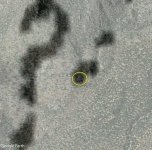
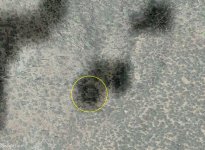
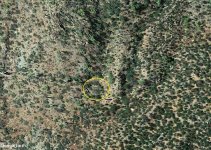
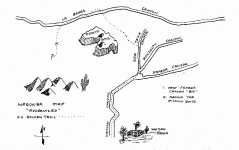
 . The most logical argument is to think like Wagoner did.
. The most logical argument is to think like Wagoner did.
